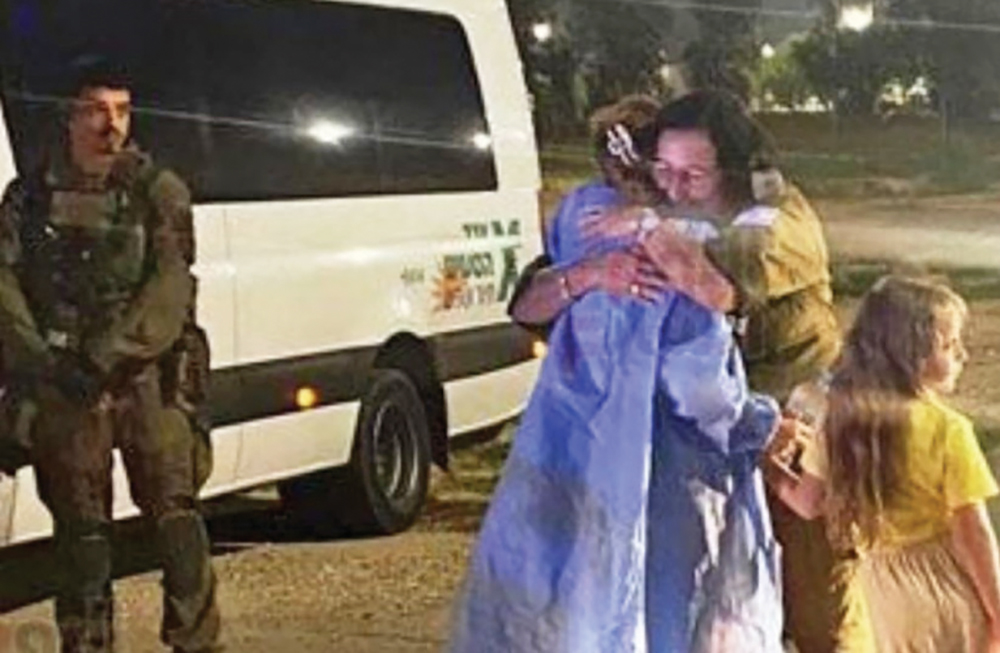
(Credit: Maariv Online)
Doha seeks to mediate a deal that would allow for the release of all the hostages, as Israel waited to see another 10 return home Wednesday night, November 29, as part of a process that has so far seen 60 Israelis freed.
Qatar and Egypt, which are mediating indirect talks between Hamas and Israel in Doha with the help of the US, are reportedly working on two deals simultaneously, with the larger one possibly including an end to the Gaza war that began on October 7 but has been on hold since Friday.
The first arrangement could see the release of 20 to 30 Israelis over the next two to three days through an extension of an existing deal, leaving slightly less than 150 in captivity by Sunday. The issue is highly pressurized because the existing deal is set to expire Thursday morning with the resumption of the war.
The second larger deal under discussion would allow for those 150 Israeli captives, out of the 240 hostages Hamas seized during its infiltration of southern Israel on October 7, to be freed.
The initial deal which went into effect on Friday has sought to secure the release of all 98 women and children in Gaza. To date, there are still some eight Israelis ages 18 and under who are forcibly held in the enclave.
Initial Release Based on Three Formulas
The initial release was based on three formulas. Ten Israeli hostages are worth 24 hours of a lull in the Gaza War, which has been paused since Friday morning to allow for captive releases. For every day the Gaza war is on hold, at least 200 trucks of humanitarian aid can enter the Strip.
For every Israeli woman or child captive freed, Israel would release three jailed Palestinian women and minors held on security-related offenses. To date, some 180 such prisoners have been freed and another 30 are set to be released tonight.
Mossad chief David Barnea, CIA chief William Burns and Egyptian intelligence chief Maj.-Gen. Abbas Kamel are in Qatar to discuss the matter. US Secretary of State Antony Blinken is set to arrive in Israel this week.
Barnea and Burns have sought to extend the initial deal and simultaneously put in place a new one to deal with male hostages, five female soldiers and those who have perished.
An article about the potential deal published in the Washington Post on Wednesday said the new deal would separate the remaining hostages into five categories. These would be men who are too old for reserve duty, male reservists, men serving in the army, the five female soldiers and those who have perished.
The breaking point is expected to be any inclusion in the deal of an end to the Gaza war. Israel has been clear about its intention to resume its military campaign to oust Hamas from Gaza once the hostages are freed. Hamas, in turn, wants to free hostages in exchange for an end to the war.
Israel has considered Hamas to be an existential threat that must be eliminated since the October 7 attack in which the terror group killed over 1,200 people, burning, dismembering and raping many of them.
Foreign Governments Make Separate Deals With Hamas for Hostages
Governments with foreign nationals in Gaza have been able to make separate deals with Hamas, via Qatar, to free their citizens without any hostage release. The US secured the release of two American women in October, but the eight Americans still held in Gaza all have Israeli citizenship.
A Filipino woman and some 25 Thai citizens have been freed. Russia was able to secure the freedom of one captive with dual Israeli citizenship and is seeking to free others outside the confines of the existing deals.
US national security spokesperson John Kirby said the US was hopeful Hamas would release more Americans, and the US government would work with Qatar to extend the pause in fighting.
“We want to see all the hostages out. The way to do that is these pauses,” Kirby told reporters traveling on the president’s plane on Tuesday.
The temporary ceasefire has allowed about 800 aid trucks to enter Gaza, and the first of three US planes with humanitarian supplies for Gaza landed in Egypt on Tuesday.
UN aid chief Martin Griffiths was to travel to the Jordanian capital Amman on Wednesday to discuss opening the Kerem Shalom crossing to allow for humanitarian aid to enter Gaza from Israel.
Located at the intersection of Israel, the Gaza Strip and Egypt, the Kerem Shalom crossing transported more than 60% of the aid going into Gaza before the current conflict.
Aid for Gaza now comes through the Rafah crossing on the Egyptian border, which was designed for pedestrian crossings and not trucks.









